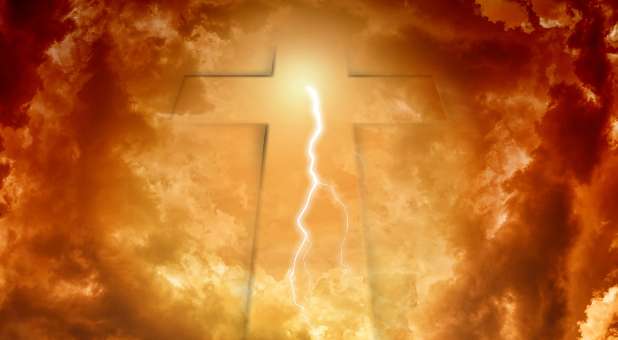The prophetic seers are at it again. Events such as a Middle East war, a tsunami, a killer earthquake or a Katrina-style weather phenomenon strike the planet, and the prophetic teachers and secular soothsayers begin chirping their warnings like birds in April announcing spring has arrived. Since Christ rode a cloud to heaven from the top of the Mount of Olives in Jerusalem, centuries of prophetic preachers and teachers have tried to discern every other cloud of global conflict looming over the horizon as the cloud through which Jesus may return. Are we really in the time of the end, and if we are, just what is the time of the end?
First, the time of the end is not the end of time—a phrase often repeated when believers speak about the last days. The phrase “end of time” is not found in either of the Testaments. Neither is the time of the end the end of the world as some suggest. The concept that the world is going to end is a misunderstanding of a verse in the English translation of Matthew’s Gospel. Christ predicted:
And as he sat upon the mount of Olives, the disciples came unto him privately, saying, Tell us, when shall these things be? and what shall be the sign of thy coming, and of the end of the world?
—Matthew 24:3, KJV
The phrase “end of the world” paints a picture on the canvas of the human imagination of a total annihilation of the planet and the complete apocalyptic destruction of mankind. However, since the New Testament was written in Greek, the meanings of certain words differ in Greek from English. For example, there are three different Greek words translated as world in Matthew chapter 24, the famous Olivet discourse where Jesus is predicting the signs of Jerusalem’s destruction, the future Tribulation, and His return to set up His kingdom. These three Greek words for world are:
| The Word in Matthew | The Greek Word | The Meaning |
| The end of the world (Matt. 24:3) | aion | An age or a course of time |
| Gospel preached in all the world (Matt. 24:14) | oikoumene | The globe; the earth (Roman Empire) |
| Tribulation impacting the world (Matt. 24:21) | kosmos | The inhabited world |
In Matthew 24:3, the disciples were asking Christ to reveal the signs of His return. When Jesus spoke of the “end,” He was not alluding to the end of planet earth but the “end”—aion, or the end of the age. These Jewish disciples, raised in synagogues and understanding prophetic writings, were taught that the Hebrew prophets foresaw a coming kingdom in which a Messianic figure would rule the world, Israel’s enemies would be defeated, and the Jews would become the leading ethnic group. All nations would amass in Jerusalem once a year to worship (Zech. 14:16). The prophet Daniel made such a prediction:
“I saw in the night visions, and, behold, one like the Son of man came with the clouds of heaven, and came to the Ancient of days, and they brought him near before him. And there was given him dominion, and glory, and a kingdom, that all people, nations, and languages, should serve him: his dominion is an everlasting dominion, which shall not pass away, and his kingdom that which shall not be destroyed” (Dan. 7:13–14).
The phrase “Son of man” is used 108 times in the King James Version of the Old Testament. God addressed the prophet Ezekiel as “Son of man” 93 times. Once, in Daniel’s prophecy, the Messiah was identified as “one like the Son of Man, coming with the clouds…” (Dan. 7:13). In the New Testament, Jesus calls Himself “the Son of Man” on numerous occasions (John 1:51, 3:13, 6:27). Christ came preaching the gospel of the kingdom, performing miracles and predicting the future of Israel. The disciples discerned He was the Messiah (Son of man) who Daniel prophesied would bring forth the final, victorious kingdom on earth (Dan. 7:18, 22, 27).
According to Jesus, several key signs would occur before the final Messianic kingdom would be set up in Jerusalem. He predicted the final age would be preceded by wars and rumors of wars, famines and pestilences in various places (Matt. 24:6-7). He warned them that enemy armies would surround Jerusalem and eventually level the city and the temple (Matt. 24:2; Luke 21:20). He gave them advanced warning that great persecution would follow, and families would turn on one another, breeding offenses and hatred (Matt. 24:9-12). Christ then revealed the premier indicator that would climax the age of man:
“And this gospel of the kingdom shall be preached in all the world for a witness unto all nations; and then shall the end come” (Matt. 24:14).
The spread of the gospel throughout the Roman Empire in the disciples’ day was a sign of the fullness of time for Israel, Jerusalem, the temple and the Jewish people. From the Day of Pentecost around A.D. 32 when the church was birthed until A.D. 70 when the Roman Tenth Legion invaded Jerusalem and destroyed the city, eventually plowing it under one year later, the gospel of the kingdom had been preached around the Mediterranean Sea in what we call the Middle East, Europe and Asia Minor. The end came for Israel, Jerusalem and the temple just as Christ predicted in Matthew 24:1–2.
Today, some well-meaning but theologically lame individuals attempt to prove that all of the prophecies related to the time of the end and the return of Christ were fulfilled between A.D. 66 and 70. They quote the historian Flavius Josephus, saying that the events of which he speaks give evidence that all the cosmic signs predicted by Christ have been fulfilled. These events recorded by Josephus included strange cosmic activity—a star shaped like a sword hanging over the city and a comet that appeared over Jerusalem—for one year prior to the destruction. He also told of a supernatural light that was seen at night, and the eastern gate of the inner court, “shut by 20 men, and rested upon a basis armed with iron, and had bolts fastened very deep into the firm floor, which was there made of one entire stone, was seen to be opened of its own accord about the sixth hour of the night.”
When I’m told that Matthew 24 was fulfilled in A.D. 70, I remind the person to keep reading all of Matthew 24, which predicts the destruction of the temple, the signs of Christ’s coming and the end of the age. The latter part of Matthew 24, verses 15–21, did not occur in A.D. 70, or for that matter at any other time in past history. These signs include:
◆ The abomination that makes Jerusalem desolate by standing in the holy place (Matt. 24:15)
◆ A Great Tribulation such as has never been seen in world history or shall ever be (Matt. 24:21)
◆ The shortening of the days of the Tribulation for the elect’s sake (Matt. 24:22)
◆ The sun being darkened, the moon not giving light and stars falling (Matt. 24:29)
◆ The Son of man appearing in the heavens for all to see (Matt. 24:30)
◆ Angels gathering His elect from the four areas of the earth (Matt. 24:31)
The above events have not yet happened but will unfold at the time of the end. This small three-letter English word end is also used several times in Matthew’s Gospel and is important to understand when answering the question: Are we really in the time of the end?
The disciples asked for the signs of the end of the age. This word in Greek means “the completion, or the consummation of a thing.” W. E. Vine’s Expository Dictionary of Old and New Testament Words says the word end “does not denote a termination, but the heading up of events to the appointed climax.” The disciples were requesting certain indicators of the completion and consummation of the age. The word end is used in Matthew 24 when Jesus warned of wars, famines and pestilences, saying that when these things were seen happening on earth, they were “the beginning of sorrows” (v. 8), but “the end is not yet” (v. 6). The Greek word end (telos) in this passage is a common word also used in Matthew 24:13 when Jesus said, “…endure unto the end” (KJV), and in Matthew 24:14, which says that after the gospel is preached around the world, “then shall the end come” (KJV).
In these references the Greek word is telos, which has a variety of meanings, including, “to set out, to reach a final goal, the uttermost and the conclusion of a thing.” According to Thayer’s Greek Lexicon, telos alludes to a “termination, the limit at which a thing ceases to be.” In Greek writings, telos always indicates the end of some act or state, but not the end of a period of time, which they call (in Greek) teletutte.
Notice this word indicates the termination of something but not the end of a time period. In other words, Christ is revealing that certain signs will indicate the termination of one age and the beginning of another. It does not refer to “the end of time,” a term that some use but that is not found in Scripture. The concept of the end of time possibly comes from Revelation 10:6, in which during the future Tribulation an angel states, “There should be time no longer” (KJV). A clearer translation is, “Time will no longer be delayed.”
This verse in Revelation alludes to how the prophetic events surrounding the Great Tribulation, which occurs at the time of the end, will suddenly accelerate like an 18-wheeler going downhill without any brakes. Once the final time is set in motion, the prophecies will come to pass faster than one can keep up with! There will be no restraining of events, as the restraining power will be removed (see 2 Thess. 2:1–8). The actual meaning of “the time of the end” refers to when certain prophetic signs related to the return of Christ begin to merge in one season and during one generation.
Jesus warned His generation that they would see the destruction of Jerusalem because their forefathers were guilty of killing
the prophets:
“Wherefore, behold, I send unto you prophets, and wise men, and scribes: and some of them ye shall kill and crucify; and some of them shall ye scourge in your synagogues, and persecute them from city to city: That upon you may come all the righteous blood shed upon the earth, from the blood of righteous Abel unto the blood of Zacharias son of Barachias, whom ye slew between the temple and the altar. Verily I say unto you, All these things shall come upon this generation” (Matt. 23:34–36).
Just as Christ predicted a final season (end) would come for Israel, Jerusalem and the temple (fulfilled in A.D. 70), the prophets of Scripture also predicted a future generation that would witness the return of the Jews to Israel from the Gentile nations, the rebuilding and expansion of Jerusalem under Jewish control, the blossoming of the land, and a restoration and rebuilding of the temple.
There was a living generation that remembered the predictions of Jesus and saw Jerusalem surrounded by armies between A.D. 66 and A.D. 70 and witnessed the destruction of the Holy City. Most traditional prophetic scholars believe that the generation that witnesses the restoration of Israel and Jerusalem and the return of the Jews will be the generation of the time of the end. The apostle Peter gave a dynamic revelation of the link between these future restorations and the return of Christ.
Perry Stone is the best-selling author of numerous books, including There’s A Crack in Your Armor, The Judas Goat, and Unleashing the Beast, from which this article is adapted. He directs one of America’s fastest-growing ministries, the Voice of Evangelism, and lives in Cleveland, Tennessee, with his wife, Pam, and their two children.
See an error in this article?
To contact us or to submit an article






















